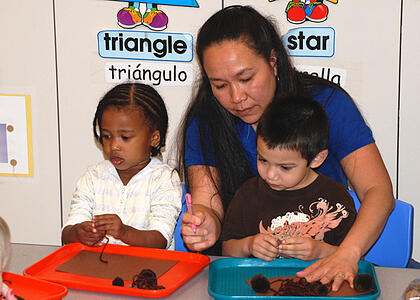
When we’re looking at Quality of Feedback, we’re really looking at what children know, understand, and do—and how teachers respond in ways that build from there to expand their learning, understanding, and persistence.
Beyond feel-good statements
Coding Quality of Feedback (QF) can be tricky. It involves distinguishing between feedback that’s rote or general (“good job” “terrific!”) and feedback that stretches children’s thinking and pushes their learning. Look for ways teachers reinforce what children are doing well and encourage them to keep going. For instance, if a child is struggling to complete a matching game and the teacher says, “You’ve worked so hard on this, matching the shapes together. Just two more to go and you’ll have the whole thing done,” she’s specifically recognizing and reinforcing what the child’s already done (worked hard, matched shapes) and encouraging him to continue. That’s true Quality of Feedback; it goes beyond general praise to build on the child’s specific accomplishments.
Different from regular conversations
Sometimes people code interactions as feedback loops under Quality of Feedback when they really fit better as frequent conversations under Language Modeling. Both indicators do share a behavior marker (back-and-forth exchanges), but the key difference between them is that a feedback loop occurs in response to something a child does or says and has the goal of expanding the child’s learning and thinking (rather than of getting a child to talk, something considered in the Language Modeling dimension). So, if a child is drawing a puppy, and the teacher asks her if she has a new pet, a general conversation, one that will support their relationship and her conversational skills, will probably result. However, if the teacher asks about why the child drew the puppy’s tail so long, her goal is to get the child to understand her thought processes more deeply. Both approaches are valuable—but they have different goals that determine whether the interaction fits best in QF or another dimension.
Always in response, not always verbal
Another tricky aspect to Quality of Feedback is remembering that it only “counts” as feedback if it’s in response to something a child says or does—and it doesn’t have to be verbal. So, if a child is having a hard time stringing beads, and the teacher holds the string or hands beads to him, then she is scaffolding his completion of the task. On the other hand, if a teacher asks, “What is the starting sound for fox?” and then adds before children have a chance to respond, “F-f-f, fox” it would not be coded under QF, because it’s not in response to anything children have said or done. It can’t stretch their thinking and expand their understanding, because it’s not building from where children are (they might, in fact, already know fox starts with the |f| sound).
At any time of day
Finally, remember that Quality of Feedback can be provided at any time of day and during any activity, so always look for evidence of it. While it’s true some activities typically see less QF (transitions) and some typically see more (small groups, one-on-one time), this doesn’t have to be the case and isn’t always.
See it in action
Watch this teacher as she responds to a child’s comment and work. Notice how their feedback loop is different from a conversation, how it pushes the child’s thinking and expands her understanding of her work.
Learn more
I highly recommend our Instructional Support Strategies online course to support your work with teachers and our CLASS Calibration webinars to keep your coding skills fresh.

